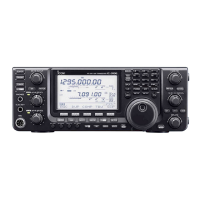86
7
DV MODE PROGRAMMING
1
2
3
4
5
6
7
8
9
10
11
12
13
14
15
16
17
18
19
20
21
D “UR” (Destination call sign) programming
A destination call sign must be programmed to a spe-
cific individual station or a repeater, for both digital
voice and low-speed data communications.
q Push [DV•DR] to select the DV mode.
w
P
ush [MENU] one or more times to display the “M3”
screen (Menu 3).
•IntheDRmode,p
ush [MENU] once or twice to select
the “D1” screen.
e
P
ush [CS](F-1) to display the “CS” screen (Call
Sign).
r
P
ush [Z](F-1) one or more times to display the “UR”
screen (UR call sign setting).
t Rotate [MAIN DIAL] to select the desired call sign
memory between “U01” and “U99.”
y Push [EDT](F-3) to enter the call sign programming
mode.
•Acursorappearsandblinks.
u Rotate [MAIN DIAL] to select the first character to
input.
When inputting numbers, push the appropriate key-
pad key.
•Push [DEL](F-4) todelete theselectedcharacter or
number.
•Push[SPC](F-5)toinputaspace.
i Push [Ω](F-2) to move the cursor backwards, or
push [≈](F-3) to move the cursor forwards.
o Repeat step u to enter UR call sign.
•Acallsignofupto8digitscanbeset.
!0 Push [MENU] to store the programmed call sign.
!1 Push [MENU] again to return to the “CS” screen.
✔ For your information
The IC-9100 has a call sign edit record function.
When you edit a call sign that is stored in a call sign
memory, the edited call sign is automatically pro-
grammed into a blank channel.
If all call sign memories are already programmed, the
edited call sign will overwrite the selected channel’s
call sign.
The programmed call sign can be over-written anytime,
when the “Edit Record” item is set to OFF or Select, in
the DV Set mode. (p. 119)
However, the call sign that is stored in a regular mem-
ory or call channel must be manually overwritten.
(Temporary operation is possible).
[CS]/[√] [EDT]
[MENU] [DV・DR] [MAIN DIAL]
CS UR
CQCQCQ
MY
R1
R2
NOT USE
Ú
UR
Ú
≈
CQCQCQ
UR
CLR EDT NAME GRP

